MotoGP announcers Nick Harris and Gregory Haines are rarely at a loss for words. But at the end of last weekend’s Indianapolis Grand Prix, the pair fell silent as they wondered, like many watching, who was that “rare ol’ chap” with the checkered flags hugging race-winner Marc Marquez on his victory lap? Well, that chap was Kevin Clark, a professional flagman for 25 years and official starter for AMA Pro Flat Track since 2009.
Clark started “hanging around and doing promotions” on the flat-track scene in 1990. One night, his friend, the late Pete Giammalvo, offered him a flag. “I wouldn’t mind doing that,” Clark replied. After the race, Giammalvo’s wife, Connie, said, “Kevin, I think you found your niche.”
It takes a certain kind of person to stand in front of a pack of motorcycles going 140 mph. “It’s hardcore,” admitted Clark, who rides and races himself. “That’s why I love it.” Clark is carrying on the legacy of stylish flaggers and sites “all of ’em” as his inspiration.
“In my day—the ’60s, ’70s, and ’80s—they were called starters,” colorful former racer David Aldana said. “They started the races with the flags. I preferred the manual start; you could read the starter.” Aldana recalled a particular flagger, Duke Pennell. “He would grit his teeth, like he was angry with the world. The angrier he got, the sooner the flag would drop. But then he would try and catch you over the line. He would purposely wait and just stand there delaying the start.”
Clark has adopted some of Pennell’s moves into his routine. “You have to keep the flag up straight, and you gotta keep it entertaining,” said Clark, who was also inspired by starter virtuoso “Airborne” Al Wilcox, a former racer who flagged for 52 years.
According to his dear friend, Roger Lyle, Wilcox was a “short powerhouse” best known for his gravity-defying jumps and pink pants. “He had a uniform for every day of the week,” Lyle said, “but his favorite was the pink suit.”
Pennell, who also used to race, crashed into a wall and lost the use of his left arm. He would drape the flag over his left knee, completely showing the flag to the racers. “He would wave it very slowly,” Aldana said, “but enough to see it.”
"After Duke's crash," Lyle recounted, "other racers took up a collection for him to get surgery to remove his arm. He took the money and bought a Cadillac. Duke said if he had the surgery, the doctor would have his arm and a new Cadillac. This way, he got to keep his arm and get a Cadillac."
Whether it was “Bouncing Bob” Malley doing flips in his Evel Knievel-style jumpsuits or Wilcox and his pink pants, flagging is, Clark described, “like a three-ring circus. It’s a show. Some stuff evolves for the better, some stuff is worth keeping around.”
Clark was born in New Hampshire, but he grew up in Massachusetts not far from Winchendon, where he runs a riding school. After the death of his mentor, Giammalvo, Clark and his friends took over the Wachusett Valley Riders Club. He says it is a throwback to old-school clubs that "kept it fun" traveling to other small tracks and "sharing the love."
“He is very animated, very good to watch,” Aldana said. “I have never seen anyone use two flags.” According to Clark, the idea of using two checkered flags came from Indianapolis 500 races. “I thought, ‘Hey let’s step it up.’”
When Marquez unveiled his Aldo Drudi-designed "USA Special" Shoei helmet for the Indianapolis GP at the Indy Mile, Clark and his dual flags were immortalized. Clark and Marquez first met this past January in Barcelona, Spain, at the Superprestigio and were reunited at Indianapolis Motor Speedway with a ceremonial two-flag display following Marquez's 10th consecutive MotoGP victory.
Flagging is part of flat track, and flat track is part of America. "It is exotic to us," French MotoGP engineer and co-founder of Yamaha Tech 3, Guy Coulon, said. "We go every year." But for Clark, flat track is life. "The races are just like home," he said. "My job is to make the riders comfortable. I set the attitude—a good attitude. If I have a bad day, everyone has a bad day."










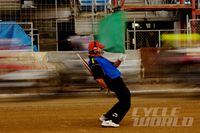
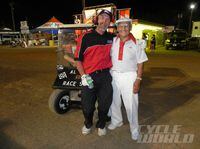
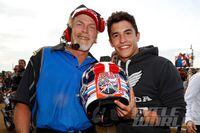
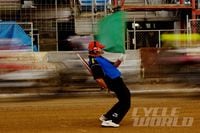
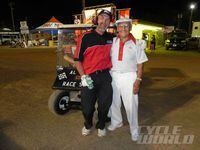
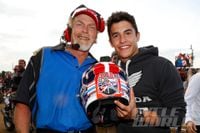
/cloudfront-us-east-1.images.arcpublishing.com/octane/HMC5X3JZHRASXGVCVNBJBWWGSI.jpg)
/cloudfront-us-east-1.images.arcpublishing.com/octane/UIWGXRZDM5HZXJOWXET2DZIWJE.jpg)
/cloudfront-us-east-1.images.arcpublishing.com/octane/QSS5DZ6SKJEU3AKE4KDAWYBEFY.jpg)
/cloudfront-us-east-1.images.arcpublishing.com/octane/SMCEQCLWRVEFTJJES6TAHB3OOQ.jpg)
/cloudfront-us-east-1.images.arcpublishing.com/octane/JCACIDCAC5FUNPTXO2BOUHGGII.jpg)
/cloudfront-us-east-1.images.arcpublishing.com/octane/DC7ZGILA2BCJXHZIUNYGV7JSEA.jpg)
/cloudfront-us-east-1.images.arcpublishing.com/octane/EWJEZUGWEZGABDEQWB64WL46GQ.jpg)
/cloudfront-us-east-1.images.arcpublishing.com/octane/5NHBMRMSFVD5JAPFNMBMNPGXQE.jpg)
/cloudfront-us-east-1.images.arcpublishing.com/octane/WHE43SCPLJBRNANAJAGXHOAIEU.jpg)
/cloudfront-us-east-1.images.arcpublishing.com/octane/6R56AQAW6NDE7BBIJ3SMCOOY5A.jpg)
/cloudfront-us-east-1.images.arcpublishing.com/octane/JMQTUE2FKZFURJTJXDMM4V47AQ.jpg)
/cloudfront-us-east-1.images.arcpublishing.com/octane/P2QYJDMQNVEANMQFXHNB3OVFKQ.jpg)
/cloudfront-us-east-1.images.arcpublishing.com/octane/VNKGXM4AA5BPRGERJOPV6GADAQ.jpg)
/cloudfront-us-east-1.images.arcpublishing.com/octane/2WS4YIFLTNG25L25WP7ZFLSWJM.jpg)
/cloudfront-us-east-1.images.arcpublishing.com/octane/UXRS6ZVQZFC23FY2EDYNT5WMVA.jpg)
/cloudfront-us-east-1.images.arcpublishing.com/octane/7JETMCKNVRGDZIGB3JCITGLPUU.jpg)
/cloudfront-us-east-1.images.arcpublishing.com/octane/OZV6E2KNIJDVHGOKXQQ2AHKLHQ.jpg)
/cloudfront-us-east-1.images.arcpublishing.com/octane/XSKMIBFZIZDN7JC6P7SMNMD3QA.jpg)
/cloudfront-us-east-1.images.arcpublishing.com/octane/ITVHWHVQ75BQBHACERYDJLPLHE.jpg)
/cloudfront-us-east-1.images.arcpublishing.com/octane/M3QRBSQ4VFEVPKYTTM3OETVFBU.jpg)
/cloudfront-us-east-1.images.arcpublishing.com/octane/H3EMT5NJ5BDZPBBH27SW3ADQH4.jpg)
/cloudfront-us-east-1.images.arcpublishing.com/octane/XTROSHDZFJB5DIJYU2VF2REFIU.jpg)
/cloudfront-us-east-1.images.arcpublishing.com/octane/7EUSM4GQEBEFTPAYZ6MOMKMMUQ.jpg)
/cloudfront-us-east-1.images.arcpublishing.com/octane/ZN44KZLHD5CHVIY3WZYAGTPGSI.jpg)